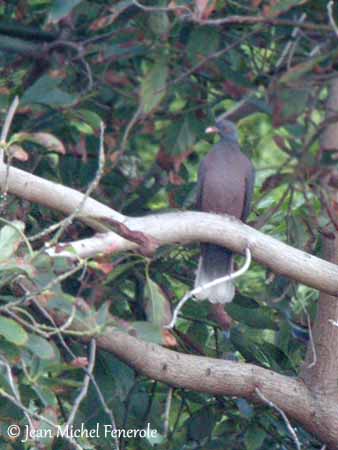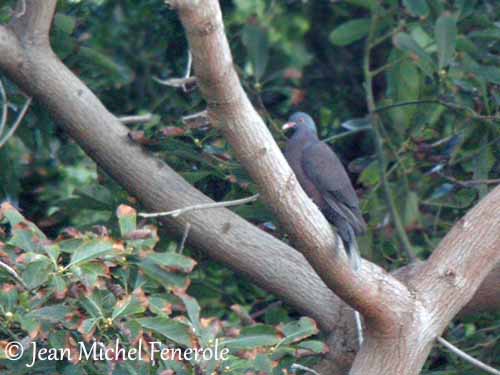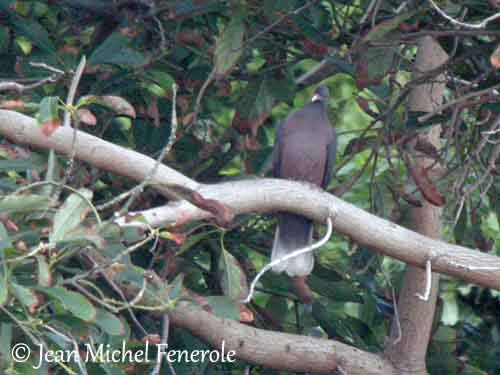
Fr: Pigeon des lauriers
All: Lorbeertaube
Esp: Paloma Rabiche
Ita: Colomba dell'alloro
Nd: Laurierduif
Sd: Lagerduva
Photographer:
Jean Michel Fenerole
Photos d’Oiseaux du monde
Text by Nicole Bouglouan
Sources:
HANDBOOK OF THE BIRDS OF THE WORLD vol 4 by Josep del Hoyo-Andrew Elliott-Jordi Sargatal - Lynx Edicions - ISBN: 8487334229
PIGEONS AND DOVES by David Gibbs, Eustace Barnes and John Cox -Pica Press Sussex - ISBN: 1873403607
BirdLife International (BirdLife International)
Wikipedia, the free encyclopaedia
Action Plan for the White-tailed Laurel Pigeon
Laurel Pigeon
Columba junoniae
Columbiformes Order – Columbidae Family
INTRODUCTION:
The Laurel Pigeon is endemic to the Canary Islands but it is restricted only in the western islands.
This pigeon is usually difficult to see because it inhabits the laurel forest in the mountainous parts of the islands, often cloud-covered during the year.
DESCRIPTION OF THE BIRD:
Biometrics:
Length: 37-38 cm
The adult has glossy green crown, nape and upper neck, turning iridescent reddish-purple on lower neck and upper mantle. The upperparts are mostly dark sepia-brown. The lower back and the rump are dark bluish-grey, becoming paler on the uppertail-coverts and the two central rectrices. The outer tail feathers are bluish-grey, ending in indistinct whitish terminal band, more conspicuous on the underside of the tail.
The underparts are wine-red from breast to undertail-coverts. The undertail feathers are grey with whitish terminal band.
On the head, forehead, face and throat are dark grey with green to mauve gloss. Crown, nape and neck show extensive green gloss.
The bill is reddish at base and pale pinkish on the second half to the tip. The eyes are orange, surrounded by red eyering. Legs and feet are red.

Both sexes are similar, but the female shows slightly paler neck and breast.
The juvenile is duller and browner, with rusty-brown fringes to wing-coverts.
RANGE:
The Laurel Pigeon occurs on La Palma and Gomera Islands in W Canary Islands. It is established on Tenerife since 1975 where it is now a breeding species.
HABITAT:
The Laurel Pigeon frequents steep areas and laurel forest in the mountainous parts of the islands. It is usually seen in deep canyons and steep slopes, up to 1600 metres of elevation.
However, this species can be found at the lower limit of the laurel forest in scrubby areas. But at the upper limit, it mainly frequents pine forested areas. At lower elevation, it tends to move towards cultivated areas.
CALLS AND SONGS: SOUNDS BY XENO-CANTO
The Laurel Pigeon produces a deep booming sequence of notes used as advertising call and regularly repeated. These sounds are mainly heard in the early morning in late August, or after rain “boooo hooooo ooo OOO”. We can also hear some crooning “pu-pu-pooo”.
They also give a display call “ruruh, ruruh…ruh…ruh”.
BEHAVIOUR IN THE WILD:
The Laurel Pigeon feeds primarily on berries of Laurus azorica, Ocotea foetens, Persea indica and Ilex canariensis, all endemic plant species to Macaronesia. It also takes fruits, buds, some grain and flowers. It can be seen feeding in adjacent cultivated areas where it can find cherries, wheat and barley. It may occasionally visit orchards.
The Laurel Pigeon feeds both in trees and on the ground where it can run very quickly.

This species performs the typical courtship displays of Columbidae. The male rises in flight with loud wing-clap and then, it glides down with spread wings and tail. This display is usually repeated 2-3 times.
Another display occurs on the ground where the male performs several bowing movements with inflated neck to display the iridescent feathers, while the tail is raised and alternatively fanned and closed. Calling accompanies this behaviour.
They have been seen displaying and strongly defending the territory in August, but breeding usually takes place from April to June.
The Laurel Pigeon is resident in its range and only performs some altitudinal movements from mountains to cultivated areas for feeding.
It has fast and direct flight, performed with regular wingbeats. The take-off is often accompanied by loud wing clattering.
REPRODUCTION OF THIS SPECIES:
The breeding season usually occurs between April and June, but it may occur throughout the year.
The nest is typical of Columbidae, a loose structure of twigs, small branches, ferns and grasses. It is often placed in cavity or rock ledge, in dead tree or beneath trunk or stones, high in canyon’s walls but always protected by the cover of the laurel forest.
The female lays a single white egg, rarely two. The incubation lasts 18-20 days. The chicks leave the nest 22-24 days after hatching, but they remain in the surroundings with the adults for the first few weeks.
The chicks are preyed upon by Black rats (Rattus rattus). These predators are the main factor involving the scarcity of the Laurel Pigeon on Tenerife.

PROTECTION / THREATS / STATUS:
The Laurel Pigeon has suffered extensive habitat loss due to exploitation of the laurel forest, and to fragmentation of the remaining forest. Degradation of the habitat by livestock (sheep) occurs on El Hierro and La Gomera. Rats and feral cats are the main predators of eggs, chicks and adults. The illegal hunting remains a threat at drinking and feeding areas. Recreational activities disturb the nesting birds. They are also potentially threatened by avian diseases.
Currently, the Laurel Pigeon is listed as Near Threatened.